Ophrys, Serapias &
Comperia
Ophrys
is a genus that grows in Southern, and to some extent, in Central
Europe. In Sweden we have just one of these species, namely Ophrys
insectifera, also growing in Norway. In Germany and southern England
four species may be found: Ophrys insectifera, holoserica, apifera and
sphegodes. In Hungary an additional species, Ophrys scolopax, is native.
This species was introduced to a site in Germany many years ago and it
is now well established there.
Much effort has the last 10
years been done – more or less reasonably – to separate the Ophrys genus
into a vast number of different species (for the moment more than 250!).
However, there is a debate going onn concerning the correctness and
sense of this. On the one hand there are the “morphologists”, finding a
new form = a new species behind every bush, on the other hand there are
the DNA-analysers, arguing for just a limited number of true species
with some variations within the species. See also below, in the text
about Ophrys hybrids!
All Ophrys, several
Mediterranean Orchis, Serapias and similar species are amongst the most
easily asymbiotically propagated orchids. Typically they exhibit a high
germination rate and rapid development, in common with the situation in
the wild where the short Mediterranean growing period requires hurried
growth. On sterile media they behave similarily.
Sowing medium: “Standard
medium” with the addition of 1 cm3 turnip in each flask à 20 ml medium.
A few species germinate better on pine-apple-juice medium – but
most species seem to grow on much better on turnip as organic complex.
Ophrys insectifera (of Swedish
origin) seems to be one of the species prefering potato – pine-apple
juice all the way, like Dacts, most Orchis etc.
Sowing time:
April-June, possibly July. Different species have a little different
growth speed on medium. Best thing is to have mature little tubers on
medium next April-May, in order
to come in phase with 4-5 months dry resting period after that, and then
given water from Sept-early October (but a much shorter resting period
for British and German Ophrys species
Seed treatment: Thin seed coats,
normally 0,3-0,5% NaClO for 4-8 minutes.
Germination:
In some cases after 2 days, in most cases 2-4 weeks. Exception:
(Swedish) Ophrys insectifera, see below!
Growth on medium:
No problems, se photos. One transplanting to fresh medium at 3-5 mm
size. They produce nice little tubers on medium after 7-10 months, to be
potted in soil early next summer.
Temperature?
Interesting question!
Now, we can see differences between on the one hand the Mediterranean
species programmed for a short vegetation period without threatening
cold winter and on the other hand species/clones growing in Central
Europe (and Sweden).
Ophrys holoserica, apifera and
sphegodes from Central Europe have a slightly slower growth first autumn
on medium. They do not neccessarily need a cool treatment, but
significantly benefits by being kept cool 3-4 months (8-10-12
centigrades) in weak light first autumn/winter while leaves are
developing. In spring they grow very quickly, producing good tubers, see
photo.
Ophrys insectifera
is a plant that in Sweden only grows on wet marshes on
lime-stone, never on summer-dry habitats! It has a very short
underground resting period, if any. In late summer, often while the old
leaves still are green, a short new leaf develps for next years´ shoot.
On the other hand, expecting a cold Swedish winter, this little leaf
stops growing at 10-15 mm size – but survive heavy frost. If sown late summer – on potato
plus pine-apple-juine-NH3 – just 10-20% of the seeds germinate after 4
weeks, and grow very slowly. However, if the flasks are kept cool, but
frostfree during winter, more than 50% of the seeds will germinate
before spring, and all protocorms/plants now grow very quickly,
producing long leaves, a big tuber and a small new shoot in August. This
illustrates an adaption to Swedish climate. But don´t keep the plant dry
after potting in soil, there is a new shoot and a small root!
Potting in soil:
Standard soil from lime-stone
areas or similar, possibly with a little sand added to give good
drainage. The little tubers from medium should be kept “dry” but not
“too dry” first summer in soil. A simple trick is to add “a little”
water to the pot when the soil has dried out, and then put it all in a
plastic bag for 4-5 months. After given water from Sept or Oct, 75-95%
of the tubers will develop leaves.
Ophrys from Central Europe
should have a “semi-dry” resting period for just 4-6 weeks, just like
Central European Orchis/Anacamptis.
Flowering:
Almost all species and hybrids
bloom in their 2nd year in soil, which is slightly less than
3 years after sowing. Some strongly growing species and hybrids flower
regularily at 2 years age if given good care, which is during their
first year in soil.
Growing these Mediterranean
species in more northerly parts of Europe
requires the adoption of somewhat artificial conditions. Temperatures
must be kept above 0 C for most of the winter – and 8-10 is better – and
a little extra light should be provided. With care and possibly a little
luck, however, excellent growing conditions can be achieved giving great
pleasure to the grower the dark months of winter and early spring.
Ophrys species from Central
Europe: holoserica, apifera, insectifera
and sphegodes, on the other hand, are easy to grow in the garden in
those areas (such as England and Germany) with a suitable climate. In
order to test their hardiness, they have been grown in Denmark and
preliminary results are very good. We raise Ophrys apifera (incl var.
trollii), holoserica and sphegodes in large numbers. The demand for
these species is much greater than for those from the Mediterranean.
Ophrys hybrids are very easy to raise and
it seems that any two species can be crossed to produce vital offspring.
The F1 generation of any particular cross exhibits just a small of
floral variation. We have grown 14 or 15 different hybrids to flowering
size so far but, with very few exceptions, it is worth noting that the
F1 hybrids are sterile. In some cases they produce empty seed capsules
and, in other cases, just a few unviable seeds.
The only exceptions that we have
found so far are Ophrys cretica x holoserica F2 and Ophrys argolica x
cornuta F2 which can be maintained in soil but the plants are very weak
and seem poorly viable.The first one will probably never flower, it is
now 8 years old and fewer and fewer plants survive each year. In the
second case, Ophrys argolica x cornuta, a small number have flowered at
4 years age, and needed 2 years on medium. However, most plants die
after producing a seed capsule. If these seeds are sown, just 2-3-4
seeds/capsule are viable – and produced similar, weak plants in a second
generation.
A very interesting
observation is that it seems to be the pollen of the F1 hybrid that is
defective. If pollen from a true species
is used to fertilise a hybrid, then “new” hybrids develop och some of
them are sufficiently viable to grow to flowering size in soil. In this
way, more and more species can be “added” to a new hybrid. In some of
these generation, just rather few plants can be raised, but in next
maybe several more seeds are viable. We have several vital Ophrys
insectifera x tenthredinifera x speculum x cretica x holoserixa x
Spruneri in soil in this moment (winter 2008).
Whilst F1 hybrids appear to be
very similar to their brothers and sisters, hybrids containing three or
more different species, on the contrary, are very different from one
another, not two single plants from the same seed pot of the crossing
are alike. Not even two plants (of 20-25) produced similar flowers in
the crossing Ophrys lutea x tenthredinifera x cretica x holoserica that
bloomed in March 2006!
As Ophrys hybrids almost
always are sterile – with own pollen – this seems to indicate that “new”
Ophrys species do not develop from hybridizing in nature!
Common genetic variation and
common Darwinistic selection might produce “new” species, as usual.
Also, raising a number of plants
from a single, self-pollinated seed capsule will illustrate the very big
variation in markings and form of the flower within a single species.
And these individual variations are not very genetically stable, so it
will take many, many generations to produce a “new” species. Most of
the “new” Ophrys species recently described, are just natural variations
and probably not even genetically stable!
Mediterranean Orchis species can be grown
under the same conditions as Ophrys is many cases, and several, but not
all, can be propagated just as easily. Orchis papilionacea regularily
flowers two years after sowing. Orchis sancta, Orchis italica and some
more are easy to propagate and grow on. Some other species have
recently been sown. See the Orchis page!
Serapias is another genus with several
more or less well-defined species. We have propagated and grown Serapias
vomeracea and Serapias cordigera and they are just as easy to raise as
Ophrys. Serapias can form hybrids with some Orchis species, for example
Orchis papilionacea.
(If you wish to experiment with
orchid crossing, then simple freeze pollen or entire single flower of
early flowering species and use the pollen to hybridize with species
that bloom later. The pollen appears to retain excellent viability, but
we have so far not tested pollen that has been frozen for more than 5-6
months.)
Comperia comperiana is a rare species from
Turkey and some of the Greek islands. We recieved seed on one occation,
and after some trial and error, discovered that the plants should be
raised the same way as Himantoglossum. Just a dozen plants were
retrieved from medium but grew well in soil. Hopefully flowering 2008,
4th year in soil.
In summary, species from the
Mediterranean area exhibit the advantage
of rapid growth and great beauty and in many cases are very easy to
propagate. Of course, the climate poses problems for growing the plants
in Central and Northern Europe, but nevertheless, it seems likely that
Central European Ophrys species have the potential to become common
garden plants.
|

Ophrys holoserica in a pot |

Ophrys argolica, note the variation in shape and
markings |

Ophrys straussii |

Ophrys insectifera x tenthredinifera |

Germinating Ophrys lutea... |

and 6-8 months later on |

Mature tubers of Ophrys lutea, to be potted in
soil, then kept semidry for 4 months |

and then given water |

Ophrys sphegodes first year in soil, photo
December |

Different size; Ophrys argolica and Ophrys
regis-fernandi |

11 |

Ophrys holoserica first year in soil, photo March
(extra light in winter) |

Ophrys insectifera, sown October, kept at 4-6
degrees C, photo February.. |

and growth speeds up quickly in summer |

Ophrys insectifera, kept on medium until October... |

and flowering first year in soil, photo in
May |

Ophrys (+ Mediterranean Orchis) are potted in soil
in April-May... |

...but don´t exsiccate them, keep a little
moisture in the soil - for example this way |

Ophrys first year in soil - will bloom following year |

Oprhys grown under artificial light |

Ophrys tenthredinifera |

Ophrys cretica |

Ophrys argolica |

Ophrys Bertolonii |

Ophrys speculum |

Ophrys lutea - note the variability! |
|

Ophrys cornuta - note the variability! |

Ophrys regis-fernandi |

Ophrys scolopax |
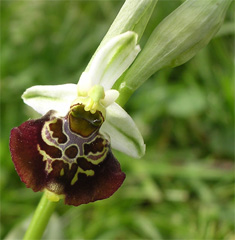
|
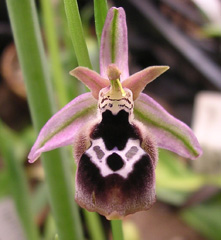 |
|

Ophrys apifera (from Germany) |

Ophrys apifera Trollii |

Ophrys lutea x tenthredinifera |

Ophrys insectifera x holoserica |
|

Ophrys lutea x speculum
|

Ophrys lutea x holoserica |

Ophrys insectifera x speculum |

Ophrys cretica x holoserica, a very vigorous hybrid! |

Ophrys insectifera x lutea |

Ophrys holoserica x tenthredinifera |

Ophrys argolica x cornuta |

Ophrys apifera x holoserica |

Ophrys insectifera x tenthredinifera |

Ophrys insectifera x tenthredinifera x speculum |

Ophrys insect x tenthred x speculum x cretica x holoserica... |

...and crossed with Ophrys Spruneri, first year in soil winter
2007/2008 |

Ophrys lutea x tenthredinifera x argolica |

Ophrys lutea x tenthredinifera x cretica x holoserica
|

Ophrys Sprunerii, raised from the same seed capsule |
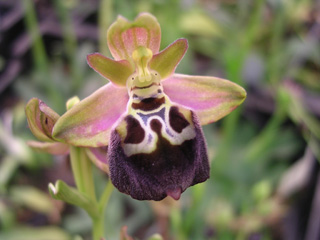
49 |

Ophrys hybrid - different flowers on the same spike! |

Ophrys hybrid |

Crazy Ophrys hybrids |

Rabbit Ophrys? |
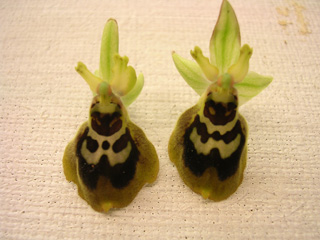 |
|

Serapias vomeracea |

Serapias parviflorum first year in soil |
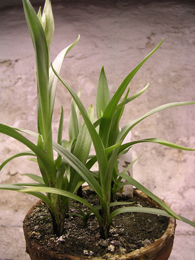
Serapias parviflorum 2nd year in soil, soon to flower |
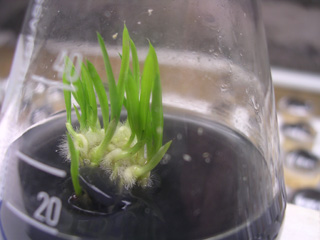
Serapias |

Comperia comperiana first year in soil |
|
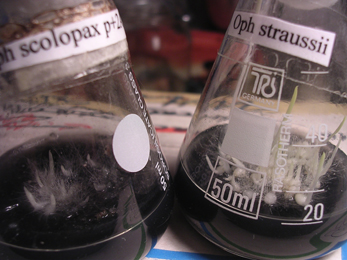
Seemingly all Ophrys can easily be propagated from seed - so go
on! |

Ophrys apifera on the left, hybrid and Ophrys scolopax |
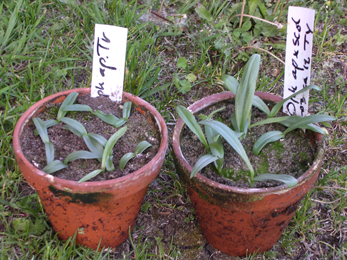
Ophrys are easily propagated - first year in soil |

...also first year in soil - 75-90% will flower following year! |
|
|
|
|
|
|
|
|
|
|
|
|
|
|
|
|
|





